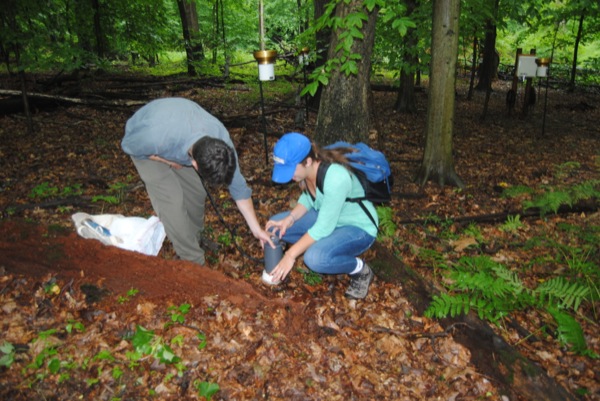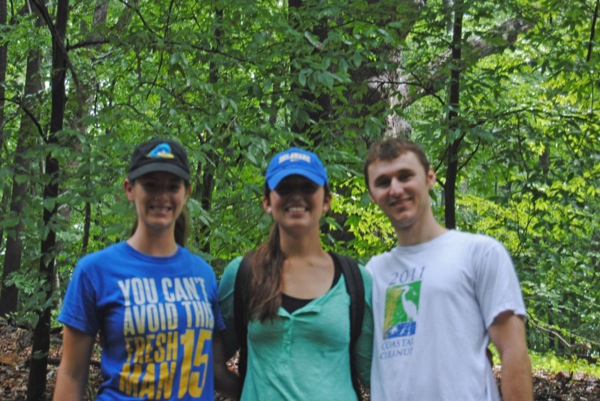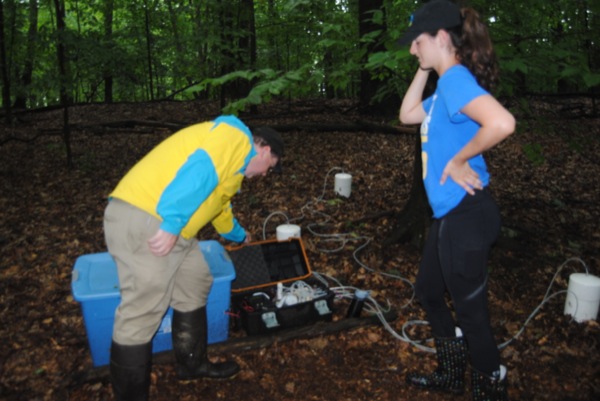


Breathing of the forest
UD undergraduates examining forests' roles in managing carbon and acid rain
9:43 a.m., Aug. 2, 2013--Traversing through the woods can be quite an adventure, especially when your adventuring includes high-tech scientific equipment.
That’s exactly what three University of Delaware students, environmental science majors Katie Junghenn and Alexey Shiklomanov from the College of Earth, Ocean, and Environment and environmental engineering major Kelsey McWilliams of the College of Engineering, are finding this summer. The trio is conducting field research at the Fair Hill (Md.) Natural Resource Management Area to help improve understanding of how forests cycle carbon through the environment and how certain species of trees interact with acid rain.
Research Stories
Chronic wounds
Prof. Heck's legacy
“Some days are better than others,” Junghenn said. “But every day would be better without ticks.”
Junghenn is working with Delphis Levia, professor of ecohydrology and director of the environmental science and environmental studies programs at UD, to measure changes in carbon dioxide concentrations in soil around two species of trees, the American beech (Fagus grandifolia) and the yellow poplar (Liriodendron tulipifera).
While trees are best known for taking in carbon dioxide and releasing oxygen through photosynthesis, they do release some carbon dioxide, too. That process, called respiration, occurs from the tree itself as well as from the soil from microbial activity.
Within the carbon cycle, a component can either be a net-sink, removing carbon from the environment, or a net-source if it adds carbon.
“Soil is one of the largest carbon dioxide sinks,” said Junghenn. “But our work will help determine if forests are net-sinks or net-sources of carbon.”
Junghenn’s research involves using an infrared gas analyzer (IRGA) with three sampling chambers that take measurements every 20 seconds. The chambers fill up with gas extracted from the ground to determine the chemical concentration. The continuous measurements allow Junghenn to study the change over time and different patterns of carbon dioxide concentrations emitted from the soil around forest trees.
The work is a continuation of research started in 2007 by Levia and Shreeram Inamdar, associate professor in the Department of Plant and Soil Sciences, to provide a complete picture of watershed hydrology and biogeochemistry, the field of science in which scientists study the interconnections between biology, geology and chemistry within an environment.
While Junghenn’s research revolves around the soil, McWilliams works with Rodrigo Vargas, assistant professor of plant and soil sciences, to study carbon dioxide fluxes across different components of the forest. McWilliams is analyzing measurements for temperature, precipitation, moisture and carbon dioxide fluxes from deadwood trees, standing trees and different locations in the soil. She is using an IRGA and manual chambers to better understand carbon dioxide fluxes across the complex terrain of Fair Hill.
By measuring the rate of change of carbon dioxide concentrations inside the chamber, McWilliams is able to calculate the flux rate at a specific point, which is very important to determine the amount of carbon dioxide that is being emitted to the atmosphere. This research provides a picture from all angles of how carbon dioxide is being released from different components of the forest — deadwood, live trees and soils — and highlights variability through time and space across the entire forest.
“These measurements will help us understand how much carbon dioxide is being lost to the atmosphere and what the relationships are between carbon dioxide fluxes and changes in temperature and precipitation,” explained McWilliams. “If the forest is taking in more carbon than what’s going out, it could be seen as a net sink and has an important implication for how carbon is stored in the environment.”
The third research project ongoing in the Fair Hill experimental watershed, supervised by Levia, is by Alexey Shiklomanov, researching how a tree’s location, in relation to the edge of the forest, affects the chemistry of the stemflow. Stemflow is the rainwater that trickles down the trunk of the tree and is one of two ways that precipitation enters the forest. The other is called throughfall — the water that falls through the leaves in the canopy.
Stemflow is important because it not only affects the entirety of the tree, but also has a major impact on microorganisms and bacteria in the surrounding soil. For his research, Shiklomanov picked 20 yellow poplar trees, seven around the edge and the rest progressing towards the center. He said he is mostly interested in how the trees handle acidity and balance chemicals.
“There are a lot of chemical processes occurring as the stemflow progresses down the trunk,” Shiklomanov said. “I’m measuring how that changes as trees move away from the edge.”
Wind can carry airborne particulates, therefore trees along the edge buffer the acid differently because they don’t have the protection from the wind that trees toward the inner-forest have.
The interns visit their sites in the forest almost every day of the week, and some weeks they go every day, rain or shine. Their research started on June 1 and goes all summer long until the interns present a poster about their topics in the spring.
Article by Andrew Cooper










